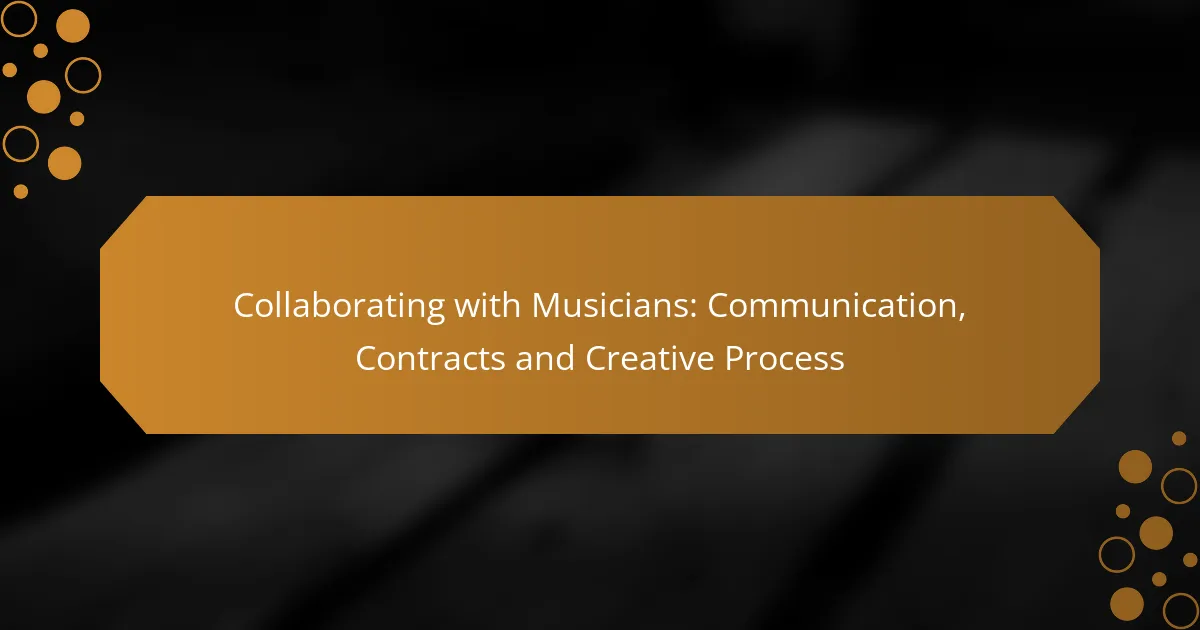Collaborating with musicians requires effective communication, where clarity and active engagement play pivotal roles in aligning creative visions. Establishing essential contract elements, such as payment terms and intellectual property rights, is crucial for preventing disputes and ensuring a successful partnership. Additionally, managing the creative process through structured collaboration and open dialogue fosters an environment where creativity can thrive.
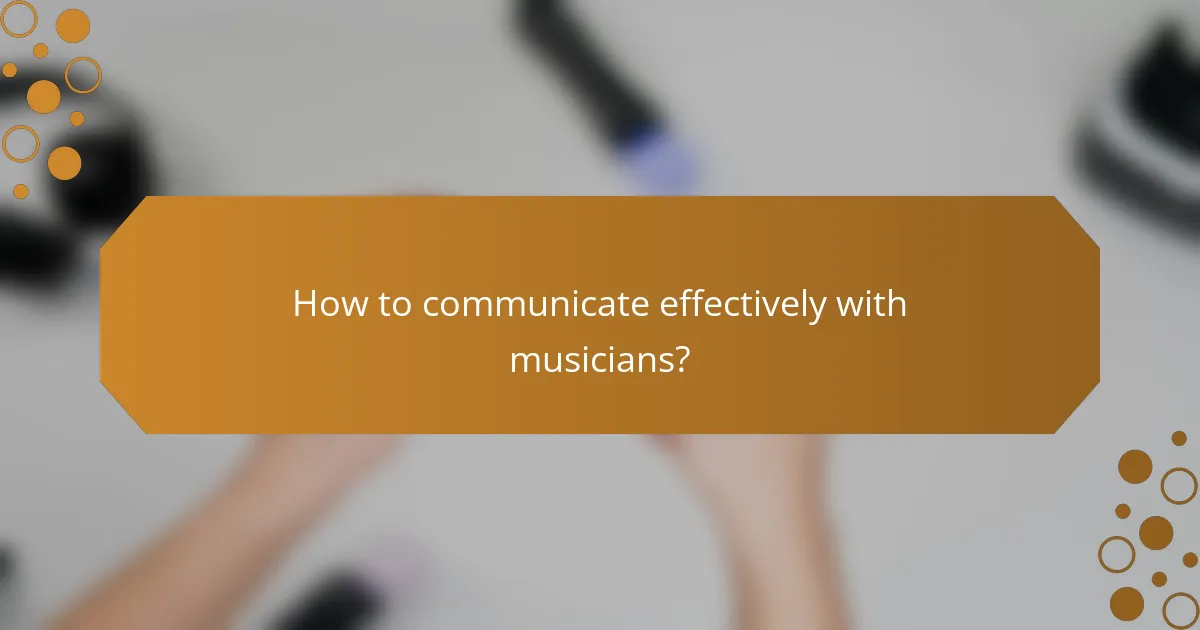
How to communicate effectively with musicians?
Effective communication with musicians involves clarity, active engagement, and ongoing dialogue. Establishing a strong foundation in these areas can enhance collaboration and ensure that creative visions align.
Clear expectations
Setting clear expectations is crucial for successful collaboration with musicians. This includes defining roles, responsibilities, and project goals from the outset. For example, specify who will handle arrangements, lyrics, or production tasks to avoid confusion later on.
Additionally, outline timelines and deliverables. A shared calendar or project management tool can help keep everyone on track and accountable. Regularly revisiting these expectations can help adjust to any changes in the creative process.
Active listening techniques
Active listening is essential when collaborating with musicians. This means fully concentrating on what the other person is saying, rather than just passively hearing their words. Techniques such as paraphrasing their ideas or asking clarifying questions can demonstrate engagement and understanding.
Encourage an open dialogue where musicians feel comfortable sharing their thoughts and feedback. This can lead to more innovative ideas and a stronger partnership. Avoid interrupting and allow pauses for reflection, which can foster deeper conversations.
Regular check-ins
Regular check-ins are vital for maintaining effective communication throughout a project. Schedule brief meetings or calls to discuss progress, address concerns, and celebrate milestones. These interactions can help ensure that everyone remains aligned and motivated.
Consider using structured formats for check-ins, such as a quick agenda or a list of topics to cover. This can help keep discussions focused and productive. Aim for weekly or bi-weekly check-ins, depending on the project’s pace and complexity, to keep the momentum going.
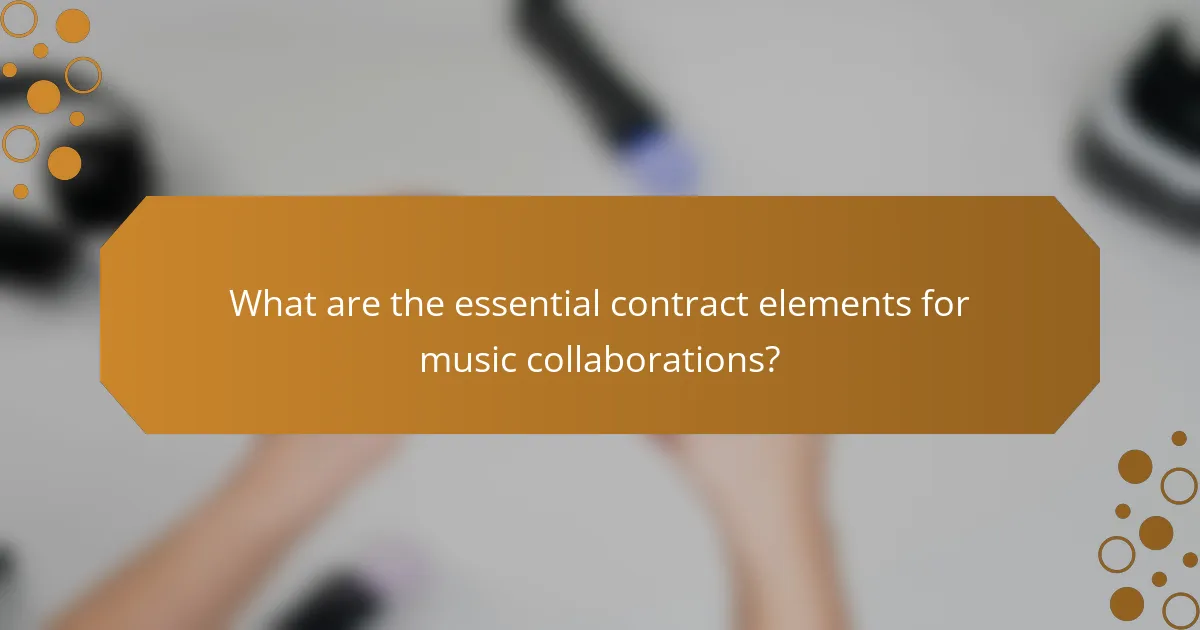
What are the essential contract elements for music collaborations?
Essential contract elements for music collaborations include payment terms, intellectual property rights, and termination clauses. These components ensure that all parties understand their rights, responsibilities, and compensation, which helps prevent disputes and fosters a successful partnership.
Payment terms
Payment terms outline how and when collaborators will be compensated for their work. This can include upfront payments, royalties, or a combination of both, depending on the project’s nature and the agreement between parties.
For example, a common structure might involve an initial payment followed by a percentage of revenue generated from the music. It’s crucial to specify payment timelines, such as monthly or quarterly, to avoid misunderstandings.
Intellectual property rights
Intellectual property rights determine who owns the music created during the collaboration. Clearly defining these rights helps protect each party’s contributions and ensures that credit is given appropriately.
Collaborators should discuss whether the rights will be shared equally or if one party will retain specific rights, such as publishing or distribution. Including clauses that address future uses of the music can also prevent conflicts later on.
Termination clauses
Termination clauses specify the conditions under which the collaboration can be ended. These clauses are essential for managing expectations and providing a clear exit strategy if the partnership is not working as intended.
Common reasons for termination include breach of contract, failure to meet deadlines, or mutual agreement. It’s advisable to outline the notice period required for termination and any obligations that remain after the contract ends, such as royalty payments or rights to the music created.

How to manage the creative process with musicians?
Managing the creative process with musicians involves clear communication, structured collaboration, and effective tools to streamline workflow. Establishing a shared vision and maintaining open dialogue are crucial for fostering creativity and ensuring that all parties are aligned throughout the project.
Collaborative brainstorming sessions
Collaborative brainstorming sessions are essential for generating ideas and fostering creativity among musicians. These meetings should be structured yet flexible, allowing participants to share concepts freely while staying focused on the project goals. Consider scheduling these sessions regularly, perhaps weekly or bi-weekly, to maintain momentum and encourage continuous input.
During these sessions, use techniques like mind mapping or free writing to stimulate creativity. Encourage all participants to contribute, and create a safe space for sharing even the most unconventional ideas. Document the outcomes to refer back to as the project progresses.
Feedback loops
Establishing feedback loops is vital for refining ideas and ensuring that everyone’s input is valued. Regular check-ins can help identify any misalignments early on and allow for adjustments before significant work is completed. Aim for feedback sessions after key milestones, such as the completion of a draft or demo.
Encourage constructive criticism by setting clear guidelines on how feedback should be delivered. Use specific examples to illustrate points and focus on the work rather than personal opinions. This approach fosters a collaborative environment where musicians feel comfortable sharing their thoughts.
Project management tools
Utilizing project management tools can significantly enhance the organization and efficiency of the creative process. Platforms like Trello, Asana, or Monday.com allow teams to track progress, assign tasks, and set deadlines. Choose a tool that suits the team’s workflow and ensure everyone is trained to use it effectively.
Incorporate features such as shared calendars and file storage to streamline communication and document sharing. Regularly review the project timeline and adjust tasks as needed to keep the project on track. This proactive approach minimizes confusion and helps maintain focus on the creative goals.
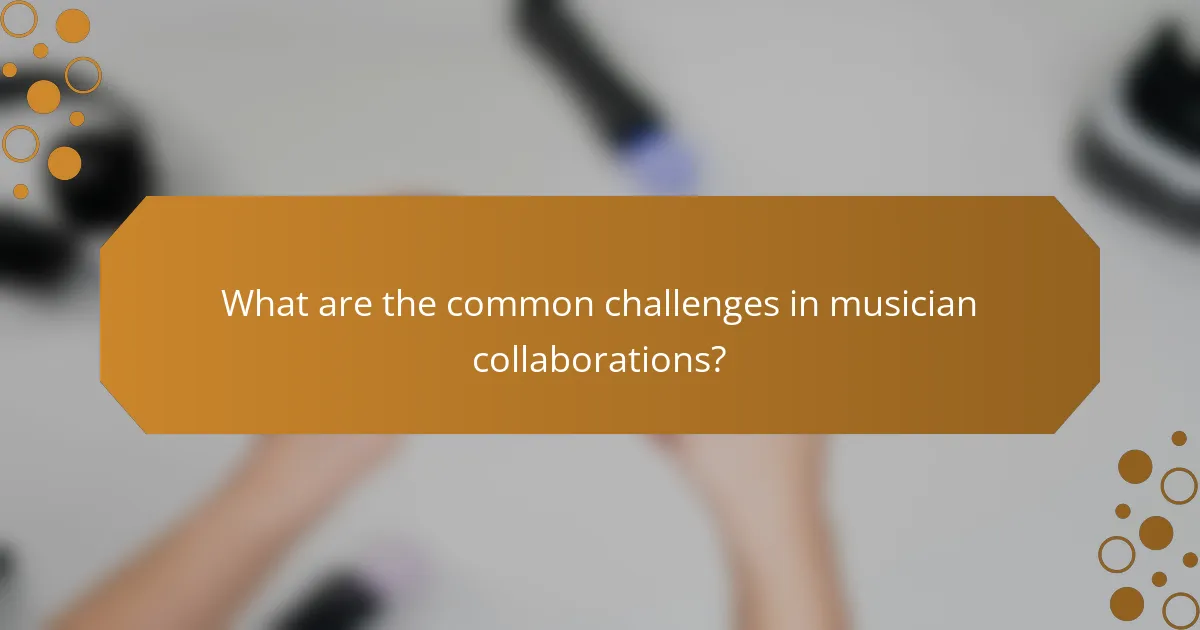
What are the common challenges in musician collaborations?
Musician collaborations often face several challenges that can hinder creativity and productivity. Key issues include creative differences, time management problems, and risks of miscommunication, all of which can impact the overall success of the project.
Creative differences
Creative differences occur when collaborators have varying artistic visions or styles. This can lead to conflicts over song direction, arrangement, or production choices. Finding a balance between individual creativity and collective goals is essential for a successful collaboration.
To navigate creative differences, establish a clear vision at the outset. Regular brainstorming sessions can help ensure everyone’s ideas are heard and integrated. Consider using tools like shared playlists or mood boards to align artistic intentions.
Time management issues
Time management issues arise when collaborators have different schedules or priorities, leading to delays in the creative process. This can be particularly challenging in projects involving multiple musicians with varying commitments, such as touring or other jobs.
To mitigate time management problems, set clear deadlines and establish a shared calendar. Regular check-ins can help keep everyone accountable and ensure that progress is being made. Flexibility in scheduling can also accommodate unexpected changes.
Miscommunication risks
Miscommunication risks can lead to misunderstandings about roles, expectations, or project goals. This can create tension and frustration among collaborators, ultimately affecting the quality of the work produced.
To reduce miscommunication, maintain open lines of communication through regular meetings or updates. Use clear, concise language when discussing ideas and decisions. Document agreements in writing, such as through emails or shared documents, to ensure everyone is on the same page.
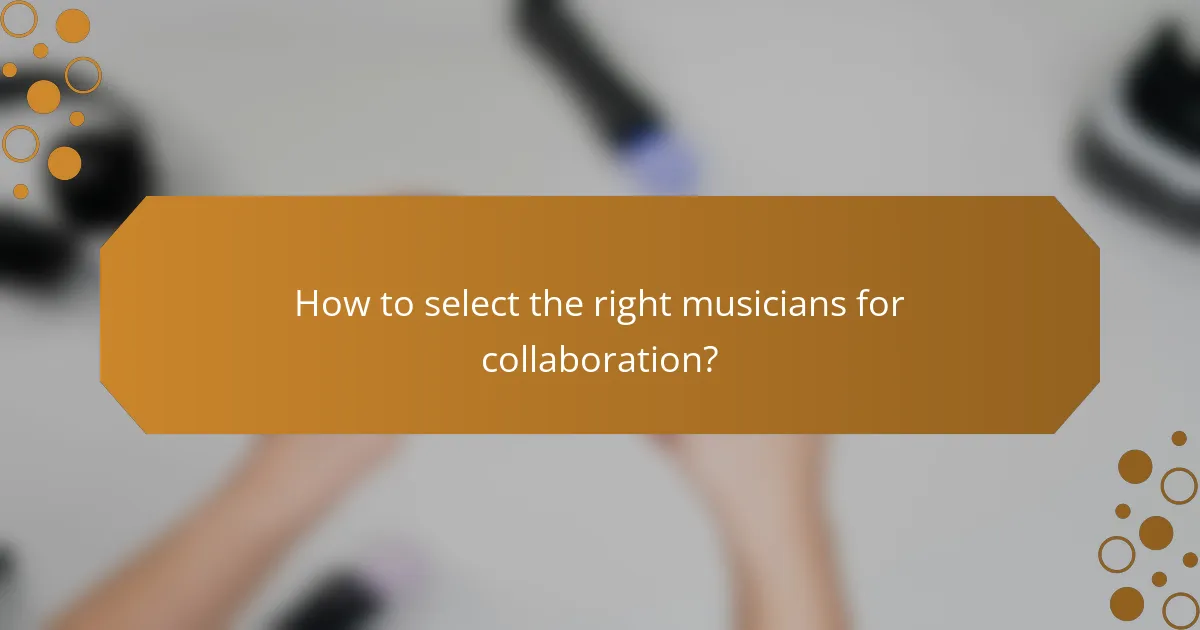
How to select the right musicians for collaboration?
Selecting the right musicians for collaboration involves assessing compatibility in musical style, evaluating their previous work, and understanding how well their audience aligns with yours. This careful selection process can significantly enhance the creative output and overall success of your collaboration.
Assessing musical style compatibility
Musical style compatibility is crucial for a successful collaboration. Start by identifying the genres and styles you both excel in and enjoy. For example, if you specialize in indie rock, collaborating with a jazz musician might require more effort to find common ground.
Consider creating a shared playlist of songs that represent each musician’s style. This can help visualize how your sounds might blend and identify potential areas for creative synergy.
Evaluating previous work
Reviewing a musician’s previous work provides insight into their skills and creative approach. Look for recordings, performances, or projects they have been involved in to gauge their experience and versatility. Pay attention to the quality of their work and how it resonates with audiences.
Additionally, consider reaching out to past collaborators for feedback. They can offer valuable perspectives on the musician’s professionalism, creativity, and ability to work within a team.
Understanding audience alignment
Audience alignment is essential for maximizing the impact of your collaboration. Research the demographics and preferences of both musicians’ audiences to ensure that your combined efforts will appeal to a broader listener base. This can involve analyzing social media engagement, streaming statistics, and concert attendance.
Consider collaborating with musicians whose audiences share similar interests or values. For instance, if both artists advocate for social causes, this common ground can enhance the authenticity and reach of your collaborative work.
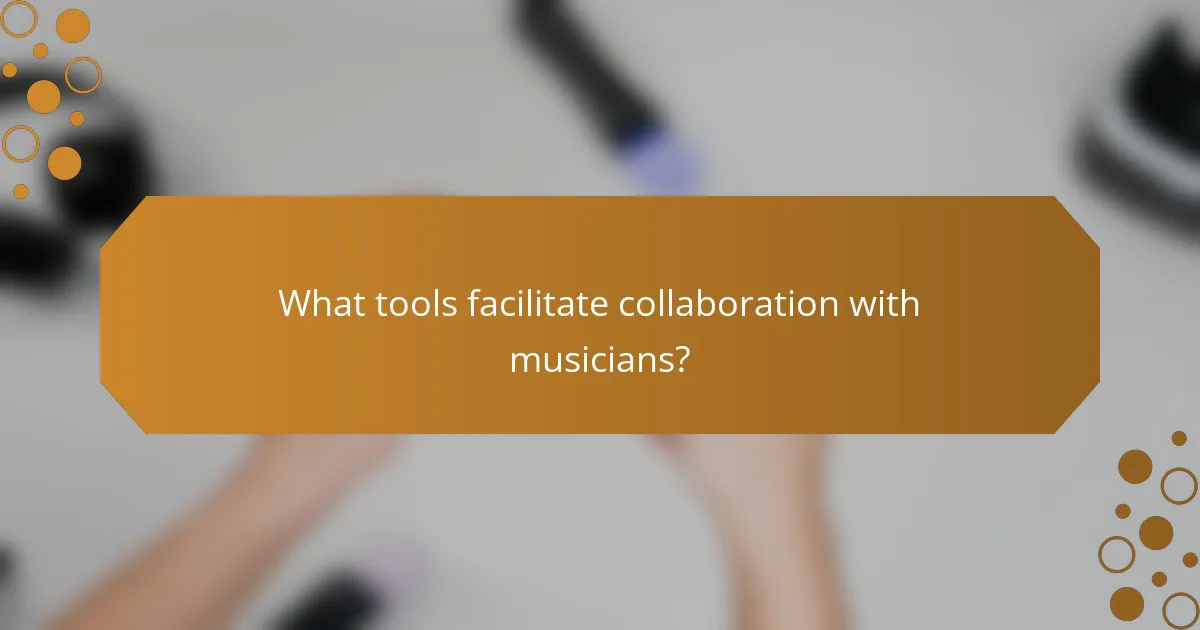
What tools facilitate collaboration with musicians?
Effective collaboration with musicians often relies on a combination of digital audio workstations (DAWs) and cloud storage solutions. These tools streamline communication, enhance creativity, and ensure that all contributors can access and share their work seamlessly.
Digital audio workstations (DAWs)
Digital audio workstations are essential software platforms that allow musicians to record, edit, and produce audio files. Popular DAWs like Ableton Live, Pro Tools, and Logic Pro offer a range of features that facilitate real-time collaboration, enabling multiple musicians to work on the same project simultaneously.
When selecting a DAW, consider factors such as compatibility with your operating system, the learning curve, and the specific features you need for your projects. Many DAWs offer trial versions, allowing you to test them before committing to a purchase.
Cloud storage solutions
Cloud storage solutions, such as Google Drive, Dropbox, and OneDrive, provide a convenient way for musicians to share files and collaborate on projects. These platforms allow users to upload, store, and access audio files from anywhere with an internet connection, making it easier to work together regardless of location.
When using cloud storage for collaboration, ensure that all team members have the necessary permissions to access and edit files. Regularly organizing your folders and naming files clearly can help avoid confusion and streamline the creative process.
